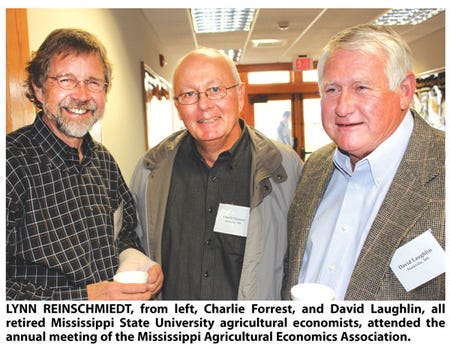
‘A perfect storm’ for ag opponents to target farm programs for cuts
With farm commodity prices having hit record highs in recent years, and with the federal government facing record deficits, “in this fiscal environment, we have something of a perfect storm for opponents of production agriculture to target all of our programs for cuts,” says Carlisle Clarke, agriculture liaison for Mississippi Sen. Thad Cochran.

With skyrocketing input costs and the volatility of prices in world markets, farmers need the “protection and peace of mind” of a farm program safety net, says Carlisle Clarke, agriculture liaison for Sen. Thad Cochran, R-Miss.
“They need this so they can continue to provide food security for the U.S. and to supply the export demands of a growing world population,” he said at the annual meeting of the Mississippi Agricultural Economics Association at Mississippi State University.
But, he cautioned, with farm commodity prices having hit record highs in recent years, and with the federal government facing record deficits, “in this fiscal environment, we have something of a perfect storm for opponents of production agriculture to target all of our programs for cuts.”
The 12-member bipartisan Joint Committee on Deficit Reduction, tasked with coming up with $1.2 trillion in federal budget cuts, “has been very tight-lipped from the beginning” about the extent of cuts for various programs, including agriculture, Clarke says.
“We in agriculture, like everyone on all the congressional other committees, have been wondering how much we’re going to be expected to give up.”
The Obama administration, he says, issued a proposal that would lop $33 billion from agriculture spending, coming from commodity, conservation, and crop insurance titles.
“The agriculture committees have been wondering what number the Joint Committee is looking for, but we’ve had no feedback.”
Chairmen and co-chairmen of House and Senate Agriculture Committees were asked to submit by October 15 a letter citing the amount to come out of their respective jurisdictions, Clarke says. “The number they came up with was $23 billion.”
Of that, he says, the consensus was that commodity titles would have to give up anywhere from $14 billion to $16 billion.
A concern in the budget-cutting process, he says, is the makeup of the Joint Committee — of the 12 members, only one is a member of an agriculture committee, Sen. Max Baucus of Montana. (D)
“Two years ago, on the Senate Agriculture Committee, we had the chairman and ranking member representing southern states. Today we have neither.
“That’s a concern, too, because it’s still not clear if there will be any type of hearings, markups, or public settings where members outside the four committee principals — none of whom represent southern agriculture — will get to weigh in with recommendations for policy changes.
“We, as Republicans and representatives of southern states, have emphasized that we need to provide producer flexibility as a policy option. If we’re truly going to make a proposal that’s equitable for all regions, we need producer flexibility.”
The Joint Committee has until Nov. 23 to issue their proposal for the target of $1.2 trillion in cuts, Clarke notes.
“Agriculture is such a small component of federal spending, and there are more sensitive issues that have to be addressed, including Social Security, Medicare, Medicaid, and Tax Reform.
No agreement on baseline
“To give some perspective, as of today the 12 members of the Joint Committee haven’t even agreed on where to start at zero to determine the baseline for the cuts. There is a very distinct possibility that Nov. 23 will come and nothing will have been been achieved by the committee.
“If they fail to come up with the $1.2 trillion in cuts, we’d then go to budget sequestration, basically putting the federal budget in the hands of the Congressional Budget Office.
“What that would mean for agriculture is that the CBO would likely cut less than $23 billion — an estimate is around $15 billion to $16 billion — but from proposals we’ve seen, they would eliminate direct payments, without touching nutrition and conservation.
“Democrats are in favor of holding on to nutrition – 44 million Americans are projected to be on food stamps next year, and nutrition programs are 75 percent of the ag budget. Some of these sacred cows will be very hard to touch in the budget-cutting process.
“We don’t know if the Joint Committee will accept our farm policy recommendations. The committee has unprecedented power; if they do come up with ag policy recommendations on their own, the scary thing is that when their proposal goes to the House and Senate for a vote, there will not be an amendment process – just a straight up or down vote.
“This process is not ideal by any means, but we’re just playing the hand we’ve been dealt at this point.”
Ironically, Clarke says, commodity programs have actually saved money under the 2008 farm bill, “so when the March baseline comes out, we’ll already be behind the 8-ball because the baseline for commodities will be smaller.”
Investment in commodity programs “is an investment in domestic food supply and global food security,” he says. “There is a limited acreage worldwide that can produce crops, and with the projected rate of global population growth the only way we’ll be able to meet these food needs is to encourage research, biotechnology, and investments in agriculture.”
In a question-and-answer session, Clarke said it remains to be seen how cuts for agriculture will be spread over the titles.
“The general consensus is that commodity titles, conservation, and nutrition would bear the brunt of the cuts in our $23 billion proposal. It’s still up for discussion what the ratios would be, but I think the writing is on the wall that commodities will get the majority of the cuts.”
Producers will still get direct payments in 2012, he noted.
“Our proposal would not take effect until the 2013 crop year, which would give producers time to restructure and adjust to any changes.”
He says, “We’re toeing the line as long as we can to keep direct payments — but a lot of people see the writing on the wall, and we’re telling commodity groups that direct payments are likely to be eliminated.
“Obviously, we’d like to use those funds and redirect them to investment in other commodity programs. But unfortunately, a lot of people in leadership positions have it as a top priority to eliminate direct payments.”
Renewable energy programs in the 2008 farm bill don’t have any baseline beyond 2012, Clarke says.
“There is no mandatory spending — it’s all discretionary. The rumor mill is that those programs will be authorized as discretionary programs, with appropriators like Sen. Cochran having authority to assign funding.”
Ethanol tax breaks are set to expire at the end of this year, as well as ethanol import tariffs, he notes.
Agriculture research programs are likely to be “relatively unscathed,” Clarke says. “A lot of research dollars are discretionary, so appropriations would provide those. The Senate did pass a mini-appropriations bill Nov. 1 that included ag research, and we should be in conference with the House in coming weeks to fund ag research.”
Agriculture is “the cornerstone of Mississippi’s economy,” he says. In 2011, the value of Mississippi agricultural production was $6.88 billion, and continuation of ag research programs “is vital to meeting this country’s future food needs.”
About the Author(s)
You May Also Like



